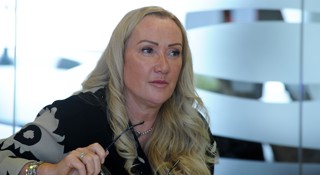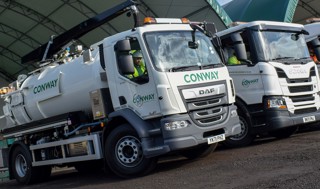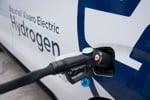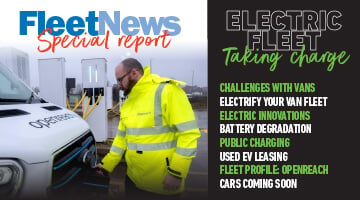This feature was originally published in the June edition of Fleet News iQ
“My initial response was ‘not a chance’!”
After a decade working for the UK’s largest energy distribution company Cadent in a variety of project manager, transition and risk management roles, Lucy Stuart had a few reservations when first asked about moving to fleet.
“It was too emotive, and I didn’t think I had the relevant knowledge,” she says, explaining her reaction when approached by senior management at the start of 2024.
She relented to accept an interim position as head of fleet & logistics. It lasted just two months; by April she was officially appointed.
So what changed? “After reflection, I realised it wasn’t knowledge of those processes that was required but the other skills I have such as stakeholder engagement, leadership and project management.”
She adds: “I know Cadent, and I understand the areas to improve and where my project management skills will help.”
By leaning on the operational knowledge of a 20-strong fleet team (including four network managers, company car specialist, fleet project manager, two data analysts, fleet technician and two compliance officers), as well as 140 staff in the logistics operation, Stuart was able to focus on the strategic and policy improvements without getting weighed down in the day-to-day detail.
“I was able to rely on our experienced team and trust their knowledge. Going into the role with no knowledge wasn’t a hindrance; it was about understanding the team, the business and the role of the fleet within our operations,” she says.
“It doesn’t matter if it’s fleet, property or operations; you simply have to understand the challenges and the organisation’s key goal, which for Cadent is to keep people safe and warm in their homes whilst saving the planet.”
Business-critical fleet of cars and vans
An employer of 6,000 staff, Cadent manages 131,000 kilometres of pipeline and supplies gas to 11 million homes and 40,000 industrial customers. Its network feeds 188 power stations and connects to 47 biomethane production plants, as well as 14 compressed natural gas fuel stations for HGVs.
To fulfil its business-critical role, the organisation relies on a fleet of 3,000 LCVs, 1,200 company cars and six tractor units.
A major assignment in Stuart’s first year heading the fleet & logistics operation was revitalising the risk and driver behaviour policy.
Overseen by the fleet project manager, the objective was to better understand the roles and responsibilities of drivers, build engagement through understanding common concerns and utilise telematics data to improve performance. Education was an underlying theme.
Policies and standards were subsequently updated, making them more user-friendly for drivers and their managers, while a permit to drive was implemented, supported by a change of licence checking provider.
In addition, a year-long programme of communications has been introduced, covering topics such as safer towing, vehicle familiarisation and fleet checks.
“We also had a driver safety stand down day where we saw a third of the van drivers to get their feedback about the initiatives,” Stuart says. “We will use that to drive our journey going forward.”
She added: “I started by making a lot of notes, engaging the board, the exec team, our insurers and the drivers. Our fleet project manager looked at the telematics data and how we were using it, and we shared the information with the engineers and trade unions, ensuring they understood the cost of accident management and how insurance works on a big fleet, but also showing our commitment to investing in the fleet.”
Decarbonising the fleet
Telematics data also supports Cadent’s decarbonisation strategy on both cars and vans by providing insight into driver journeys, usage and utilisation.
The entire car fleet has already switched to electric, with 62% full electric and 38% plug-in hybrid (PHEV), as part of a three-year transition plan.
PHEVs are permitted for drivers travelling at least 15,000 miles a year, with mileage reconciled when the car is de-fleeted to ensure they still meet the criteria.
Cadent also committed to move its first responder vehicles - mid-size vans which account for around 30% of the total LCV fleet - to electric over a five-year period. These do not travel large mileages or carry heavy equipment, making them “the logical place to start”, Stuart says.
To date, half have transitioned, making Cadent one of the leaders among its peers in the gas distribution utility sector.
“I’m proud of our progress but we’ve now reached the 50% milestone and are taking stock of our position due to the public charging infrastructure before going further,” Stuart says. “We have an obligation to get to a gas leak within an hour and so we have to have the resilience to offer a 24/7 service.
“Not everyone can charge at home and the range and lack of public charging infrastructure mean that, operationally, we can’t go any further at this time.”

All vans are home-based with around 60% of drivers having off-road parking for charging; the rest rely on the public charging network. However, they can only charge during their working hours, which can have an impacts on productivity.
Cadent supports the installation of home chargers for both cars and vans. Car drivers reclaim their business mileage at advisory electric rates while van drivers are reimbursed via the Mina system which integrates their charge point and energy supplier to ensure accurate billing and direct payment, eliminating the need for them to claim expenses.
The rest of the LCV fleet is typically 3.5-tonne vans towing mini diggers with the need for onboard power, putting them out of scope for the electric vans currently available on the market.
Cadent is trialling 50 eDeliver 7 mid-size electric vans from Maxus which offer longer range (230 miles WLTP) together with nine of the larger eDeliver 9 electric vans.
“Until this becomes the real-world range, it will be difficult for us to move the rest of the fleet to electric,” Stuart says.
“But we will continue to look at options and we certainly don’t want to roll back from what we’ve done so far – it will be electric for electric on all replacements.”
She is also responsible for six tractor units as part of the logistics operation, which make deliveries to Cadent’s 22 stores. The Birmingham-based trucks run on CNG, while Stuart keeps an eye on hydrogen developments.
“I want to get on the hydrogen journey but, like electric for our cars and lighter vans, there are issues right now with the lack of infrastructure,” she says.
Migrating funding from purchase to leasing
As if implementing an enhanced risk and driver behaviour policy alongside managing the electrification transition strategy wasn’t enough over the past 16 months, Stuart has also overseen the ongoing migration of funding from outright purchase to contract hire with maintenance, a process which started three years ago.
Around 70% of the fleet has transitioned to leasing, with the balance due to move across within the next year.
Cars, leased via Kinto, are on a four-year cycle; vans will be on a five-year lease with Novuna Vehicle Solutions.
Electric vehicles will follow the same replacement cycle, ensuring Cadent has some flexibility should technology improvements lead to increased range.
Stuart is using the renewal programme as an opportunity to ensure vehicles are fit for purpose – and this means for the driver, not just the job.
“For example, we now have microwaves in our 3.5-tonne vans so drivers can heat their food. They can’t leave the van because of potential gas escape,” she explains. “We also involved our drivers in discussions with Bri-Stor to ensure the racking is designed to suit their needs.
“We will continue to work on specification with our user groups to understand what other improvements we need to make before we go out to procure the next block of vehicles.”
Working with core partners plays a vital part in running an effective and efficient operation: they can have a fundamental impact on cost and environmental impact.
“Having a good partner on service engagement is important to deliver improvements – you need a partner you can trust,” Stuart says.
“They need to understand how you operate and the impact they can have on your fleet – for example, the importance of getting a van back on the road and the critical impact of not having it.”
She adds: “But you also need a team that wants to improve and a leadership team that believes in you.”
Stuart was recruited into fleet because of her track record of successfully delivering on key projects at Cadent. It underlines how the yardstick for a modern fleet decision-maker is evolving to incorporate a new set of skills.
“Important for this role is project management and stakeholder engagement,” Stuart says. “You need to be able to balance that with finance and budgets, while understanding and interpreting the needs of drivers and the business.
“Listening is key, but you also need to know when to say ‘no’.”
‘Shattering stereotypes’ for women in business
Lucy Stuart is a passionate advocate for diversity, equity and inclusivity, and until recently was co-chair for Women in Cadent, one of the organisation’s ED&I groups.
The group addresses perceptions around roles which are traditionally seen as male positions and aims to “shatter stereotypes”, she says.
The company has produced a series of ‘Shattering Stereotypes’ videos intended to promote and demonstrate the possibilities for women in business.
Stuart recently agreed to join the steering group for the new Fleet News initiative Empowering Women in Fleet which has been set up to highlight and celebrate women’s achievements in fleet to promote role models and empower women to reach their potential.
Factfile
- Company: Cadent
- Head of fleet and logistics: Lucy Stuart
- Time in role: 16 months
- Fleet size: 1,200 company cars, 3,000 LCVs and six tractor units
- Operating cycle: cars – four years; vans – five years
- Funding method: contract hire
- Size of team: fleet – 20; logistics 140























Login to comment
Comments
No comments have been made yet.